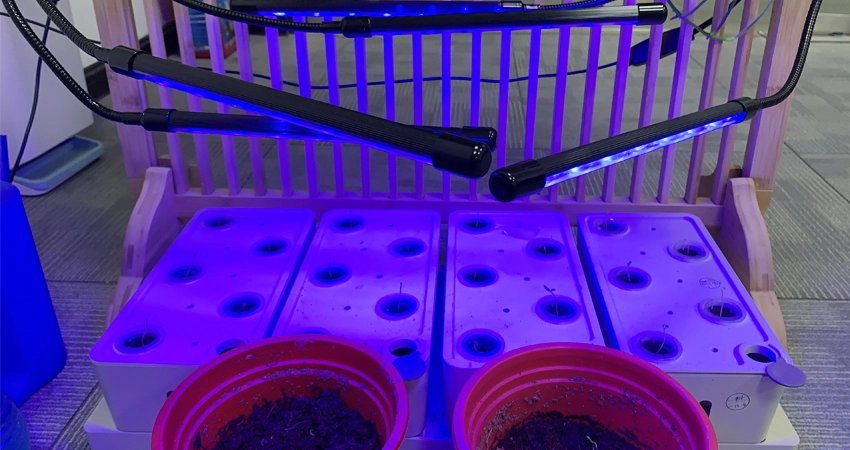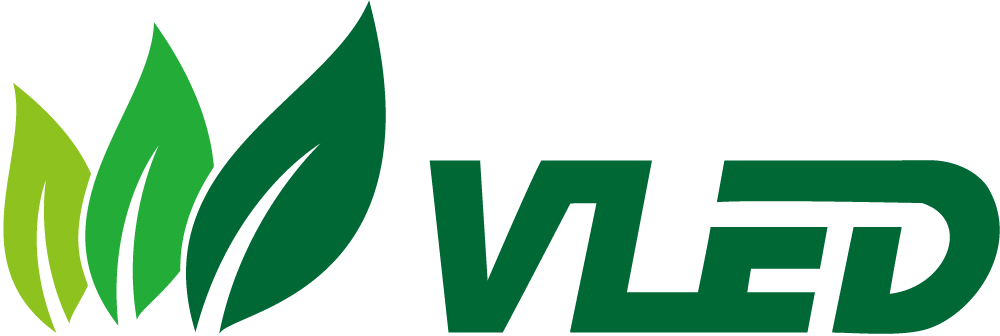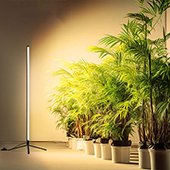Menu
Why Are Seedlings Spindly When Using Grow Lights Indoors?
These days, even gardening at home can have a high-tech twist! LED grow lights are like the secret weapons in those superhero movies, quietly playing a crucial role in the modern indoor gardening world.
However, just like every hero faces challenges, LED grow lights also encounter some hiccups in practical use.
Recently, some friends who are enthusiastic about indoor gardening have shared an interesting phenomenon with us: despite using LED grow lights with excitement, their seedlings seem a bit picky. Instead of thriving, they appear thin and weak, leaving people both concerned and puzzled.
This has sparked a hot discussion among novice growers because who wouldn’t want their seedlings to grow healthy and vibrant?
So today, let’s talk about this topic and explore which factors during the use of LED grow lights might cause our seedlings to become “thin and weak,” and how we can cleverly address them to revive their vitality and enjoy the indoor gardening adventure happily!
Table of Contents
Analysis of Reasons
Inaccurate Control of Light Intensity
Just like humans can’t sunbathe every day or hide in darkness all the time, seedlings also need moderate light.
If the light is too intense, like giving the seedlings a “sunbath,” it may burn their leaves and inhibit growth. Conversely, if the light is too weak, it’s like working in a dim room where the seedlings don’t get enough energy for photosynthesis, resulting in slow growth.
Finding the right intensity of light is crucial; it’s like the energy switch for seedlings, providing just enough to promote healthy growth continuously.
Unreasonable Light Schedule
Seedlings are not perpetual motion machines; they need rest too. If LED lights are left on for long periods, seedlings may disrupt their normal metabolic rhythm due to insufficient rest time, much like how humans feel exhausted after staying up late.
Conversely, if there’s insufficient light, it’s like slacking off during work hours, failing to complete photosynthesis tasks adequately, which naturally affects nutrient accumulation in seedlings. Over time, seedlings may appear weak.
We need to establish a scientific light cycle for seedlings, similar to scheduling regular rest, to ensure they can make the most of the light while also getting sufficient sleep.
Inappropriate Spectral Configuration
LED lights emit light in various colors, and different colors have different effects on plants.
For example, blue light helps strengthen the growth of seedling stems and leaves, while red light benefits root development and flowering. If the spectrum of LED lights mainly consists of light that seedlings don’t need, it’s like feeding vegetables to a child who prefers meat – no matter how much they eat, they won’t grow strong.
It’s essential to select LED lights with the appropriate ratio of blue and red light for seedlings at different growth stages.

Other Environmental Factors
Lighting is just one important factor in the growth of seedlings; other environmental factors also silently influence them. Just as we feel more comfortable in warm, humid, and well-ventilated environments, seedlings also prefer suitable temperature, humidity, and good airflow.
If these environmental conditions are not suitable, seedlings may feel uncomfortable, affecting their ability to uptake and utilize nutrients, ultimately making them look thin and weak.
For indoor gardening, taking care of seedlings involves managing lighting and ensuring all environmental conditions are optimal.
Solutions and Recommendations
Selecting Suitable LED Grow Lights and Light Parameters
We need to learn to “tailor” the light for seedlings. Different types and growth stages of seedlings have different lighting requirements, just like some babies prefer gentle sunlight while others prefer bright light. Therefore, when choosing LED grow lights, it’s important to be like buying clothes for a child, ensuring the right size and material (in this case, referring to the spectrum type).
For example, newly sprouted seedlings may need more blue light to promote growth, while during the growth stage, it may be necessary to increase red light to help strengthen them. At the same time, the light intensity should also be adjusted properly, ensuring that it neither burns the seedlings nor leaves them in the dark.
Simulate Natural Light and Scientifically Arrange Day-Night Cycle
Don’t forget, seedlings also need a day-night cycle just like we humans need to sleep and wake up on time. Seedlings require a proper allocation of light and dark periods.
We can gradually adjust the LED light’s on-off time according to the changes in nature, such as turning on the light in the morning and turning it off at night, to establish a stable light cycle. This way, seedlings can grow better in a consistent lighting environment.

Create a Warm and Comfortable Growing Environment
It’s not just about the lighting; the overall climate conditions indoors are also crucial for the healthy growth of seedlings. Just like how you wouldn’t feel comfortable staying in a place that’s too cold, humid, or dry and hot for too long, seedlings also require appropriate temperature and humidity levels.
Regularly check and adjust the indoor temperature and humidity to ensure that the seedlings are in their preferred microclimate.
Additionally, remember to feed the seedlings with fertilizer at the right time, just like children need nutritious meals. Applying fertilizer at the appropriate time and in the right amount ensures that the seedlings have enough energy to grow.
Moreover, pruning the seedlings promptly, and removing unnecessary parts, allows more nutrients to be concentrated on the useful parts.
Handle Special Cases with Special Care
We can provide personalized lighting solutions for certain seedling varieties that are particularly picky or have special requirements.
Some rare plants may need additional ultraviolet light or specific wavelengths of light, which require the installation of LED bulbs with corresponding functionalities.
This is akin to meeting the diverse interests and hobbies of children by providing them with special toys and courses. By carefully attending to the unique needs of each seedling, we can ensure that they exhibit their best growth potential.
Summary
Looking back, our seedlings remained weak and thin even after using LED grow lights, primarily because we failed to create the ideal living conditions for them.
- Firstly, the intensity of light is not a case of “the brighter, the better” or “the darker, the worse.” It’s crucial to find the optimal brightness level that makes the seedlings comfortable.
- Secondly, setting the light cycle is essential. We need to mimic the natural day-night cycle to ensure the seedlings have a regular rhythm.
- Additionally, the light emitted by LED lights must be in colors that the seedlings prefer. Without sufficient blue or red light, akin to children lacking essential nutrients, the seedlings’ stems, leaves, and roots will not grow well.
- Furthermore, the growth of seedlings depends on a harmonious environment. This includes maintaining appropriate temperature and humidity, ensuring proper ventilation, using fertilizer sensibly, and pruning timely. Each aspect is crucial and cannot be overlooked.
We must understand that indoor gardening is not as simple as just setting up a few lights. It’s a meticulous task that requires systematic management.
Only when every aspect is taken care of meticulously can we ensure that the seedlings grow healthy from the inside out and ultimately exhibit the best growth state.
Using LED grow lights correctly is just one part of the equation, but it’s a crucial part. Only by truly understanding and mastering these key points can our indoor gardens be full of vitality and vigor!
Get in touch with us!
From custom light planning, to tailored quotes, and everything in between, our team of horticulture experts are always ready to assist.




